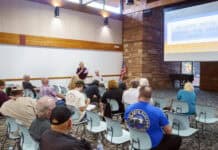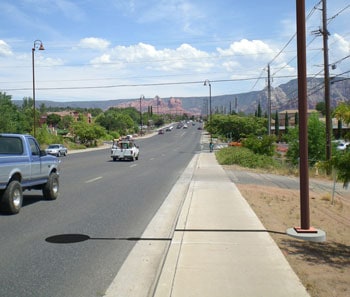As Sedona students return to school Tuesday, Aug. 11, the Sedona Oak Creek School District nurse and administrators prepare for the return of “swine flu.”
According to the Arizona Department of Education, the second wave of the H1N1 influenza is expected to hit once schools are back in session and the department urges schools to be prepared.
Pandemics typically occur in three waves, with the second being the largest and most deadly, the department stated in a document to the school district. The first wave began in spring 2009 and was officially declared a pandemic in June.
SOCSD Superintendent Mike Aylstock and district nurse Goldie Wolin don’t want to be alarmists, they said, but they do want to treat the situation seriously.
This fall, teachers will stress to students all the things they can do “to keep their germs to themselves,” Wolin said.
The No. 1 method to preventing the spread of the flu is hand washing, she said.
“It’s one of the easiest things to do and it’s one of the best things to do — soap and water for 20 seconds,” Wolin advises.
Students will also be told to cough or sneeze into the elbow instead of their hands, which touch more things than the crook of the arm.
According to Wolin, the Centers for Disease Control and Prevention recommends hand sanitizers with alcohol for killing germs, so the school will install a sanitizer dispenser in each of its three schools, near the cafeterias.
If students come to Wolin with respiratory flu-like symptoms, they will be sent home and not allowed to return until they’re symptom- and fever-free for 24 hours without fever-reducing drugs.
If teachers send a student home one day and see them in class the next, they are to send them home again since they couldn’t be symptom-free for 24 hours yet, Wolin explains.
Typically a lot of absences could hurt the school district financially since the state checks attendance the first 100 days to determine how much money the district will get the following year. The state pays school districts a certain amount per student.
But this year, it will not penalize the district for absences if they are proven to be due to H1N1, Aylstock said.
If things get too bad Yavapai County Health Department may choose to close a school, Aylstock said, something the schools won’t be able to control.
“There may be some instances where schools are closed upwards of six to eight weeks,” he said. “It would be local discretion whether or not we would have to make up that up, but we’d do everything we could so our students wouldn’t miss all that instructional time.”
According to Yavapai County, an H1N1 vaccine is forthcoming and may be ready by October.
If that is the case, the school district will work with the county to hold clinics for the community, Wolin said.
“I believe the flu is coming,” she said, and the whole community will have to work together. If parents need to pick up sick kids from school or stay home with them, she hopes businesses are understanding, she said.
Any parents with questions or concerns can reach Wolin at West Sedona School, 204-6605.
Alison Ecklund can be reached at 282-7795, ext. 125, or e-mail
aecklund@larsonnewspapers.com





















